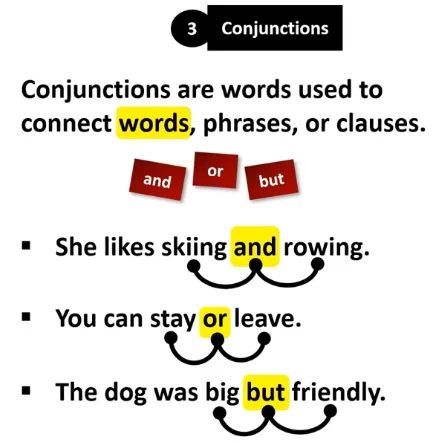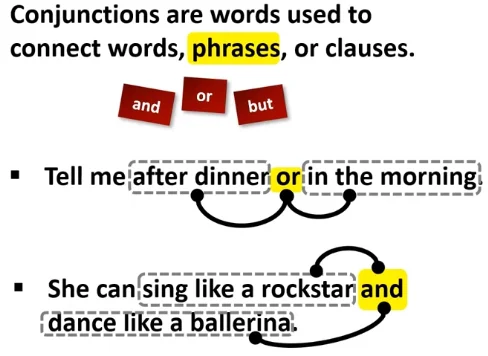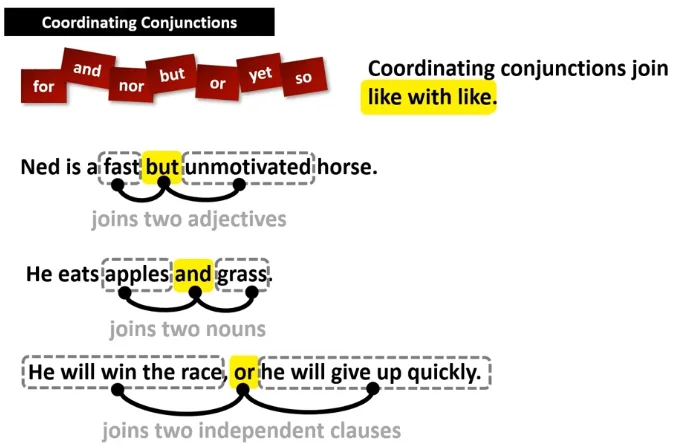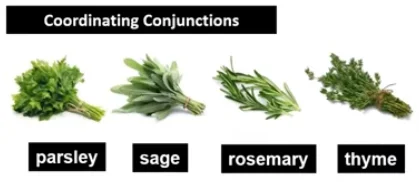Conjunctions are one of the nine parts of speech given here in alphabetical order.
Definition for Conjunctions
Conjunctions are those particular words we use to connect words, phrases, or clauses. So, here are three common conjunctions: and, or, and, but.
How do they connect words? For Example:

She likes skiing and rowing.
In this sentence= “and” is a conjunction and it connects the words “skiing” and “rowing.”
You can stay or leave.
=”Or” is our conjunction and it connects the words “stay” and “leave.”
The dog was big but looked weak.
Well=”but” is our conjunction and it connects the words “big” and “friendly.”
How they can join phrases? For Example:

Tell me after dinner or in the morning.
Here, our conjunction is= “or” and it connects the phrase = “after dinner” and the phrase =” in the morning.”
She can sing like a rock star and dance like a ballerina.
Here= “and” is our conjunction and it joins the phrase “sing like a rock star” and the phrase “dance like a ballerina.”
How do they join clauses? For Example

He stole the painting after John left but before Susan gave her speech.
Well, our conjunction is= “but.” “After John left” is a =clause.” Before Susan gave her speech” is a clause and the conjunction joins them.
He is planning to steal the painting, and he intends to sell it in New York.
Here= “and” is our conjunction and it joins the clause =” he’s planning to steal the painting” and the Clause= “he intends to sell it in New York.”
Look at the upcoming independent clauses. That means that they could stand alone as sentences, and when a conjunction joins two independent clauses like this, the conjunction is preceded by a comma. So far, we’ve looked at the conjunctions “and,” “but,” and “or” and these are called coordinating conjunctions. We can remember them with the mnemonic, FANBOYS, like this.
- For
- And
- Nor
- But
- Or
- Yet
- So
Types of Conjunctions

- Coordinating conjunctions
- Subordinating conjunctions
- Correlative conjunctions
Coordinating Conjunctions
Coordinating conjunctions join like with like. What do we mean by like with like? Well, here is an example:

Examples
Ned is a fast but unmotivated horse.
=“But” is our conjunction, and look, the word= “but” has joined two adjectives.
He eats apples and grass.
=“And” is the coordinating conjunction and this time it’s joined two nouns
. So, coordinating conjunctions joined like with like. In the first one is two adjectives in the second one is two nouns.
She will win the prize, or she will give up quickly.
Well= “or” is our coordinating conjunction and this time it’s joined two independent clauses. So, like with like, and notice that there is a comma before the “or.” Because that’s what you do when coordinating conjunction joins two independent clauses. The key point here is that it’s like with like.
More Examples
- Parsley
- Sage
- Rosemary
- thyme

Well, let’s write that out:
Parsley, sage, rosemary, and thyme.
Our coordinating conjunction is “and.” Only this time, it doesn’t sit between two things. It is sitting at the end of a list and when=” and” (or any coordinating conjunction) joins three or more items (and in this case, it’s four), then you have a decision to make.
Have you ever put a comma before it or not? Generally, Brits do not put a comma before the end but generally, Americans do. This is called a serial comma, but it’s also called an Oxford Comma after the Oxford University Press, but as a rule, Americans tend to use this serial comma and Brits don’t.
Fish, chips, and peas.
That is how most Brits would write it. Notice, there is no comma.
Burger, shake, and fries.
This is how most Americans would write it. Notice there is a comma.
This only applies when a coordinating conjunction is used in a list of three or more things.
Subordinating Conjunctions
And there are lots more. Here is a definition: Subordinating conjunctions are the second type that joins subordinate clauses to main clauses.

Here are some examples:
- After
- Although
- If
- Since
- Until
- Because
Examples
We will wait here until the rain stops.
Well= “until” is our subordinating conjunction, and it sits inside a subordinate clause and it joins it to the main clause. So, subordinating conjunction joins the clauses.
Most people are economically in crisis because the coronavirus has affected all and sundry.
Well= “because” is our subordinating conjunction, and it sits inside the subordinate clause, and it links the subordinate clause to the main clause. It joins the clauses. There’s one more thing to say about subordinating conjunctions. They don’t always follow the main clause. Sometimes, they’re in front of the main clause.
When the rain stops, we will start climbing.
Here= “when” is our subordinating conjunction and it sits inside the subordinate clause and links it to the main clause. Usually, when a sentence starts with a subordinate clause like this, it is normal to put a comma after the subordinate clause to show where the main clause starts.
Correlative Conjunctions
Correlative conjunctions come in pairs to join alternatives or equal elements.

Examples
- Either…or
- Neither…nor
- Not only…but also
These are by far the three most common correlative conjunctions.
More Examples
You can either take it or leave it.
So, =” either…or” is our correlative conjunction, and it is linking two alternatives “take it” or “leave it.”
It is not only unfair but also illegal.
So, =”not only…but also” is our correlative conjunction. This time, it’s joining two equal elements. In this example, there is an adjective after each part of the correlative conjunction. And in the above example, there are verbs after each part.
When you use the same part of speech after correlative conjunction your sentence is said to be parallel. So, the top example can be described as a parallel because each part of the correlative conjunction is followed by a phrase starting with a verb.
To raise funds, John either sold his watch or his kayak.
=”Either…or” is our correlative conjunction. But this example is not parallel. Look, a verb follows “either” but a noun phrase “his kayak” follows “or.”
So, this is wrong. Let’s correct the example. To raise funds, John sold either his watch or his kayak. This time, “his watch,” a noun phrase, follows “either,” and “his kayak,” a noun phrase, follows “or.”This one is parallel. This is correct.

